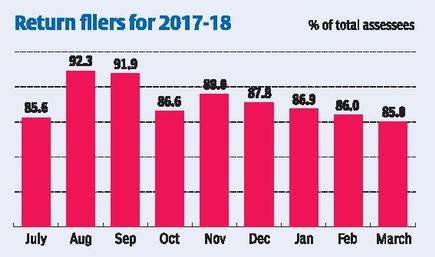जीएसटी संकट – कारण और उपाय- क्या अभी भी जीएसटी को बचाया जा सकता है !!
जीएसटी संकट – कारण और उपाय- क्या अभी भी जीएसटी को बचाया जा सकता है !!
जिस समय भारत में जीएसटी लगाया गया था उस समय भी यही बताया गया था कि जीएसटी की प्रक्रियाएं जिस प्रकार से कठिन से कठिन बनाई जा रही है और व्यापार एवं उध्योग के लिए इन्हें पूरा करना आसान नहीं होगा . इसका एक बहुत बड़ा कारण था कि जीएसटी भारत में लाया तो एक बहुत अच्छे उद्देश्य से था लेकिन इसे जिन लोगों ने प्रारम्भ में बनाया उनका एक ही ख्याल था कि जीएसटी में कर की चोरी किस तरह से रोकी जाये और इसी एक मात्र उद्देश्य ने जीएसटी की सरलीकरण की राह में बहुत बड़ी बाधा खड़ी कर दी जो कि जीएसटी का मुख्य उद्देश्य था और इस सख्ती ने आज हालात यहाँ तक पहुचा दिए है कि अब ये सवाल पूंछा जा रहा है कि क्या अब भी जीएसटी को बचाया जा सकता है ?
जिस समय भारत में जीएसटी लगाया गया था उस समय भी यही बताया गया था कि जीएसटी की प्रक्रियाएं जिस प्रकार से कठिन से कठिन बनाई जा रही है और व्यापार एवं उध्योग के लिए इन्हें पूरा करना आसान नहीं होगा . इसका एक बहुत बड़ा कारण था कि जीएसटी भारत में लाया तो एक बहुत अच्छे उद्देश्य से था लेकिन इसे जिन लोगों ने प्रारम्भ में बनाया उनका एक ही ख्याल था कि “जीएसटी में कर की चोरी किस तरह से रोकी जाये” और इसी एक मात्र उद्देश्य ने जीएसटी की सरलीकरण की राह में बहुत बड़ी बाधा खड़ी कर दी जो कि जीएसटी का मुख्य उद्देश्य था और इस सख्ती ने आज हालात यहाँ तक पहुचा दिए है कि अब ये सवाल पूंछा जा रहा है कि क्या अब भी जीएसटी को बचाया जा सकता है ?
क्या किया जाना चाहिए
आइये पहले यह देखें कि अब क्या किया जाना चाहिए ताकि इस आलेख का प्रारम्भ सकारात्मक तरीके से हो सके और इसके बाद हम देखेंगे कि जीएसटी संकट का कारण क्या है और कौन जिम्मेदार है इस स्तिथी के लिए .
1. टैक्स का भुगतान मासिक हो और जीएसटी रिटर्न त्रैमासिक किये जाए.
2. टैक्स का भुगतान चालान से लिया जाए और GSTR-3B को समाप्त किया जाए .
3. GSTR-1 को बिल टू बिल की जगह डीलर टू डीलर बनाया जाए . खरीदादर से भी डीलर टू डीलर खरीद की डिटेल ली जाए और दोनों का मिस्मेच केद्रीय स्टार पर निकाल कर विक्रेता और क्रेता के अकाउंट में शो कर दिया जाए ताकि वे इसे दूर कर सके.
4. अब तक भरे GSTR-3B में संशोधन की सुविधा शीघ्र प्रारम्भ की जाए .
5. तीन माह् में एक ही रिटर्न हो और इसमें जो भी सूचना लेनी हो वह एक साथ ही ले ली जाए . इस रिटर्न को भरने के लिए तिमाही की समाप्ति से 30 दिन का समय दिया जाए.
6. लेट फीस की राशी कर की राशि के 10 प्रतिशत से अधिक नहीं होनी चाहिए .
7. वार्षिक रिटर्न भरने के से पूर्व सभी रिटर्न्स को सशोधन करने की प्रावधान होना चाहिए.
8. मिस्मेच में सीधे ही क्रेता के विरुद्ध कार्यवाही करने से पहले यदि उसके बिल इत्यादि पूरी तरह से सही है तो पहले विक्रेता के विरुद्ध कड़ी कार्यवाही हो और उससे कर वसूल किया जाए और यदि वसूल ना हो तो रजिस्ट्रेशन निरस्त कर दिया जाए .
9. यदि क्रेता 6 माह तक भुगतान नहीं करे तो उसकी इनपुट क्रेडिट को निरस्त करने का प्रावधान है लेकिन इसकी सूचना भी क्रेता ही अपने रिटर्न में देगा . इसे परिवर्तित कर सूचना देने का यह अधिकार विक्रेता , जिसका भुगतान रुका है को दिया जाए.
10. रिटर्न संबंधी सुधारों को किसी आगे की तिथी से लागु करने की जगह तुरंत लागू किया जाए.
11. जीएसटी नेटवर्क एक बार में 1.50 लाख रिटर्न ही ले पात़ा है इसके बाद के डीलर ऑनलाइन लाइन में लगे रहते है . इसे बढा कर 15 लाख रिटर्न किया जाए ताकि आने वाले कुछ वर्षों तक जीएसटी नेटवर्क की समस्याएं समाप्त हो सके.
12. वार्षिक रिटर्न, समायोजन विवरण – 9 A , B और C को फिर से और तार्किक तरीके से ड्राफ्ट किया जाए.
13. सारे फॉर्म समय से आये, जीएसटी नेटवर्क ठीक से चलता रहे इसके लिए जीएसटी प्रबन्धन और जीएसटी नेटवर्क को पाबन्द किया जाए.
14. अंतिम दिन भी डीलर्स रिटर्न भर सकें इसकी पूरी व्यवस्था हो. जीएसटी नेटवर्क को इसके लिए पाबन्द किया जाए .
15. जीएसटी प्रबन्धन करदाताओं पर विशवास रखें और करदाता भी जीएसटी पर विश्वास रख सकें इसके लिए माहौल तैयार किया जाए.
16. सेवा क्षेत्र में 50 लाख रूपये के करदाताओं के लिए कम्पोजीशन स्कीम शीघ्र लाइ जाए. इसके लिए कम्पोजीशन कर की दर 3 प्रतिशत से 5 प्रतिशत के बीच रखी जाए.
17. कर की दरों के सबंध में केवल “Sin & Luxury” को ही 28% की दर में रखा जाए और शेष जो अभी भी 28% में हैं उनके बारे में जल्दी फैसला लिया जाए.
इस स्तिथी के कारण क्या है ?
आइये अब देखें कि जीएसटी जिस हालत में आज है उसके लिए जिम्मेदार कौन है क्या जिस तरह से जीएसटी कानून बनाया गया वह इसके लिए जिम्मेदार है या जिस तरह से जीएसटी भारत में लागू किया गया वह जिम्मेदार है. जीएसटी कानून तो मुख्यतया उसी तरह से बनाया गया है जैसा कि भारत की संघीय व्यवस्था में संभव था लेकिन जिस तरह से जीएसटी सख्ती से लागू करने के प्रयास किये गए उनमें सरलीकरण का अभाव ही इस स्तिथी के लिए पूर्ण रूप से जिम्मेदार नजर आता है .
जीएसटी में प्रक्रियाएं प्रारभ में ही इतने सख्त बनाई गई उसका एक उदाहरण प्रारम्भ में जो रिटर्न मांगे गए थे उनके बारे अब तक डीलर्स और प्रोफेशनल्स भूल ही चुके होंगे तो आइये देखें प्रारम्भ में जीएसटी प्रबंधन की क्या योजाना थी :-
ये थी और भी कठिन प्रक्रिया जो प्रारम्भ में आने वाली थी
रिटर्न का नाम विवरण कब तक पेश करना है
GSTR-1 मासिक बिक्री का विवरण अगले माह की 10 तारीख तक
GSTR-2 मासिक खरीद का विवरण अगले माह की 15 तारीख तक (10 तारीख के पूर्व यह रिटर्न नहीं भरा जा सकता है अर्थात इसे आपको 10 से 15 तारीख के बीच भरना है).
GSTR-3 मासिक कर का रिटर्न अगले माह की 20 तारीख तक.
GSTR-9 वार्षिक रिटर्न वित्तीय वर्ष की समाप्ती के बाद 31 दिसम्बर तक.
आपको लग रहा होगा की कितना सख्त प्लान था प्रारंभ में ही और हमारे ब्यूरोक्रेट्स प्रारम्भ में इसका प्रचार इस तरह से कर रहे थे कि इससे आसान जीएसटी की प्रक्रियाओं का स्वरुप हो ही नहीं सकता है . प्रारम्भ में ही विशेषज्ञों द्वारा यह आशंका व्यक्त कर दी गई थी कि हर माह इतने रिटर्न्स भरने संभव नहीं होंगे और अभी तक भी आप देखेंगें कि यह योजना लागू नही हो पाई और इसकी जगह एक नया जीएसटी फॉर्म – 3 B माह भरा जा रहा है और GSTR-1 हालात तो यह है कि इसकी तारीखें नियमित रूप से बढ़ती गई है .
GSTR-3B एक ऐसा रिटर्न था जो हर माह मांगा गया और देरी से पेश करने पर लेट फीस का प्रावधान भी था लेकिन इसके साथ ही जीएसटी नेटवर्क भी पूरी तरह से रिटर्न्स लेने को तैयार नही था और पिछले 18 महीने में कई बार संकट में पडा रहा तो ऐसे में लेट फीस ने भी डीलर्स के परेशानियों को और बढ़ाया और आज यह लेट फीस भी एक बड़े विवाद का कारण बन गई है . GSTR-3B कोई मूल रिटर्न नहीं था इसे केवल टैक्स जमा कराने के विकल्प के रूप में लाया गया था और अब इसे बंद कर केवल टैक्स के चालान से इसका काम चला लेना चाहिए.
GSTR-1 में भी सरकार प्रत्येक बिल की डिटेल मांगती है लेकिन इससे होता यह है कि इससे डीलर्स का काम बढ़ जाता है और दूसरा इससे जीएसटी नेटवर्क पर भी बोझ बहुत बढ़ जाता है आर रिटर्न्स के अंतिम दिनों में वह कभी चल ही नहीं पाया . यह काम बिल टू बिल की जगह डीलर टू डीलर डिटेल से भी बखूबी चलाया जा सकता था लेकिन इसके लिए डीलर्स पर विश्वास करना जरुरी होता है जो कि जीएसटी लागू करने के साथ ही जीएसटी प्रबंधन ने छोड़ दिया था.
सख्त कानून बनाना जरुरी है और कर चोरी रोकने के लिए इसकी सख्त जरुरत है लेकिन इसमें व्यवहारिकता का समावेश जरुरी है वो सख्त कानून किस काम का जिसका पालन करने में ईमानदार करदाता को इतनी अधिक तकलीफ हो और दूसरा आपका सिस्टम भी इसे झेल नहीं पाए. जीएसटी सरलीकरण के लिए लाया गया था लेकिन करदाता यह पूंछ रहा है कि यदि यही सरलीकरण है तो फिर कठिन जीएसटी क्या होता.
जीएसटी बिल मेचिंग का सिस्टम भी कोई बहुत अच्छा नहीं है यह भी डीलर्स के लिए एक समस्या है . पहले खरीददार GSTR-1 में अपनी बिक्री की डिटेल देता है वह खरीदादार के GSTR-2A में अपने आप चली जाती है फिर खरीददार उसे चेक कर अपने विक्रेता को सूचित करता है कि कौनसा बिल छोड़ दिया गया है . यह काम हर डीलर को अपनी खरीद चेक करने के लिए अलग –अलग करना होता है और सोचिये जब लाखों डीलर यह काम करते है तो कितना समय बर्बाद होता है.
आइये इसका विकल्प सोचें . सबसे पहले तो सरकार डीलर्स पर विश्वास करे और बिक्री की बिल टू बिल की जगह डीलर टू डीलर सुचना ले उसके बाद डीलर्स को अपनी खरीद की बिल टू बिल डिटेल भी देने को कहे . अब इससे होगा यह कि एक ही केन्द्रीय सॉफ्टवेयर इस खरीद और बिक्री को चेक कर लेगा और मिस्मेच निकाल कर विक्रेता और क्रेता को उनके अकाउंट में सूचित कर देगा जिससे वे आपस में इसे मिस्मेच को दूर कर लेंगे. इससे लाभ यह एक तो लाखों डीलर्स को अपने –अपने मिस्मेच अलग –अलग नहीं निकालने पड़ेंगे और दूसरा जीएसटी नेटवर्क पर भी बोझ कम पडेगा. 2006 में भारत में वे लगाया गया था और कई प्रयोगों के बाद जीएसटी लागू होने के पूर्व यही सिस्टम सफलतापूर्वक चल रहा था .
एक बड़ा सवाल यह भी पूंछा जाता है कि क्या जीएसटी लगाने के पूर्व कोई होमवर्क किया गया था ? इसका जवाब तो यह है कि किया तो जरुर किया होगा लेकिन उसकी गुणवत्ता कोई बहुत अच्छी नही थी. जीएसटी नेटवर्क तो ऐसा लगता है कि तैयार ही नहीं था तो फिर इसपर प्रयोग करने का तो कोई प्रश्न ही नहीं उठता है . आज हमारे कानून निर्माता भी जीएसटी को लेकर चिंतित नजर आ रहे हैं क्या इसका कारण यह है कि जीएसटी कम तैयारी और अति-आत्मविश्वास के साथ लगाया गया था और “जीएसटी रिटर्न तो कोई पडौस का बच्चा ही भर लेगा” इसका बहुत बड़ा उदाहरण है. क्या जीएसटी रिटर्न ही जीएसटी है ? ऐसा नहीं था लेकिन प्रक्रियाओं के उलझाव ने ऐसा ही बना दिया है और यही अब सच बन गया है .
अभी जीएसटी की सफलता को राजस्व की प्राप्ती से तो आंका ही नहीं गया है यह तो केवल अभी प्रक्रियाओं की जटिलता और करों की दरों में ही उलझकर रह गया है.
अब जीएसटी को बचाने का एक मात्र ही उपाय है कि जीएसटी का मूल उद्देश्य अब सरलीकरण को बना दिया ताकि जिन डीलर्स को कर एकत्र कर भुगतान करना है वे पूरी तरह से इससे वाकिफ हो सकें और एक बार यह सुनिश्चित हो जाए तो फिर जीएसटी प्रबंधन जीएसटी की प्रक्रियाओं के साथ धीरे –धीरे प्रयोग कर इन्हें और भी उपयोगी बनाए. इसके अतिरिक्त जीएसटी नेटवर्क की क्षमता और गति को बढ़ाने के उपाय भी सुनिश्चित किये जाए.
जीएसटी का उद्देश्य होना चाहिए कि भारत की अर्थव्यवस्था को एक सरल और अच्छी अप्रत्यक्ष कर प्रणाली देना जो कि जीएसटी के प्रारम्भिक 18 महीनों के दौरान संभव नही हो सका जिसके क्या कारण रहे इनका जिक्र अभी ऊपर किया गया है और अब जीएसटी को बचने के लिए इन कारणों को ध्यान में रखते हुए जितना शीघ्र हो सके उपाय किया जाना चाहिए जिनमें से कुछ उपाय ऊपर बताये गए है .
सुधीर हालाखंडी




